Business Research Methodology: Mobile Computing Opportunities
VerifiedAdded on 2023/06/07
|13
|3041
|126
Report
AI Summary
This report explores the use of mobile computing in business, examining both the opportunities and challenges that organizations face when adopting mobile technology. It begins with an introduction to mobile computing, its objectives, and scope, followed by a literature review highlighting the principles and applications of mobile computing in various sectors. The report identifies opportunities such as reduced capital expenditure and increased reachability, while also addressing challenges like network availability, security concerns, and high costs. Furthermore, it categorizes issues related to data privacy, system integrity, and communication channels. The report concludes by suggesting possible solutions, including proactive security plans, risk tolerance strategies, and promoting a security-conscious culture. The overall aim is to provide a comprehensive understanding of mobile computing's impact on business operations and strategies for mitigating potential risks.
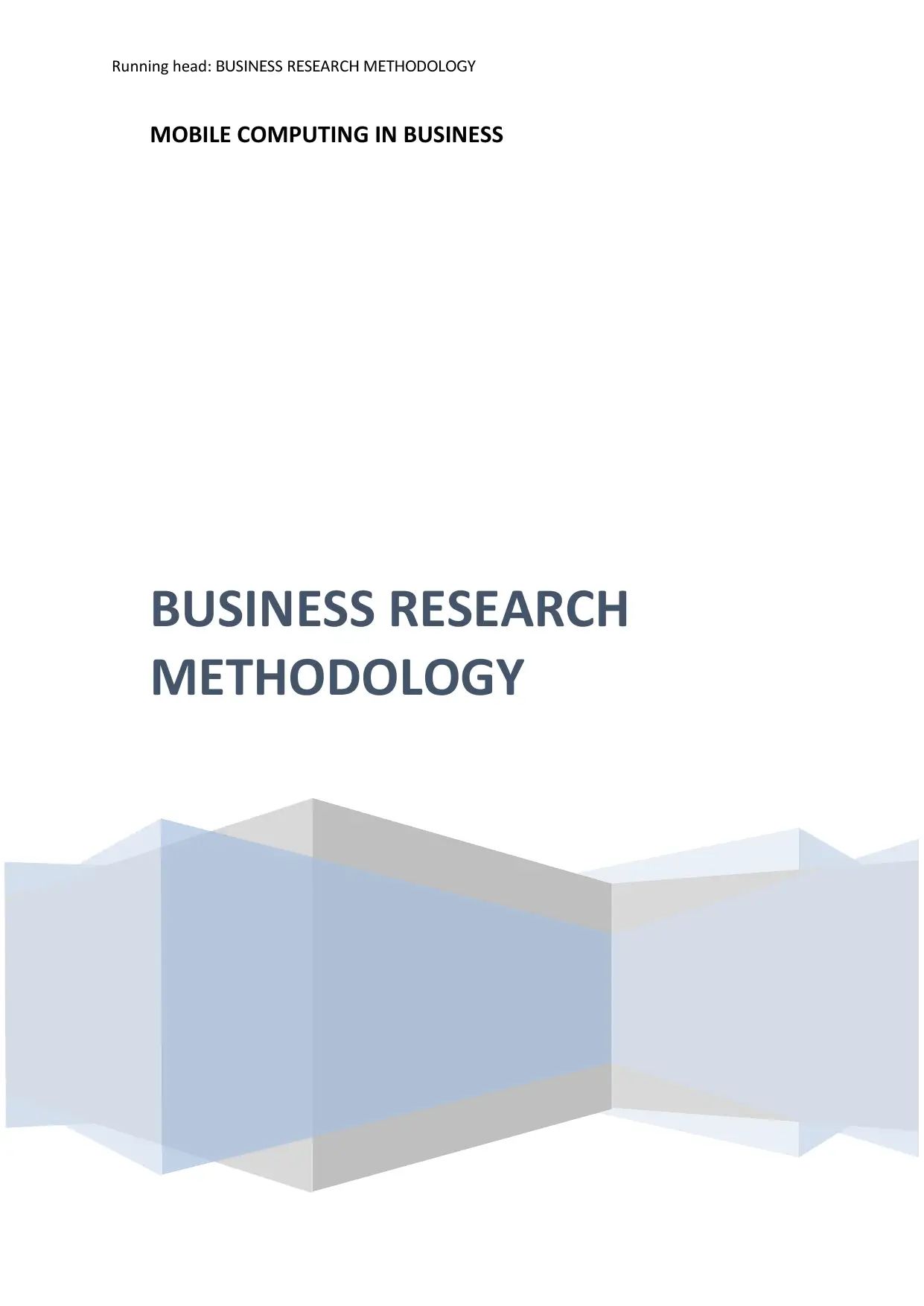
Running head S SS R S ARC M D: BU INE E E H ETHO OLOGY
MOBILE COMPUTING IN BUSINESS
BUSINESS RESEARCH
METHODOLOGY
MOBILE COMPUTING IN BUSINESS
BUSINESS RESEARCH
METHODOLOGY
Paraphrase This Document
Need a fresh take? Get an instant paraphrase of this document with our AI Paraphraser
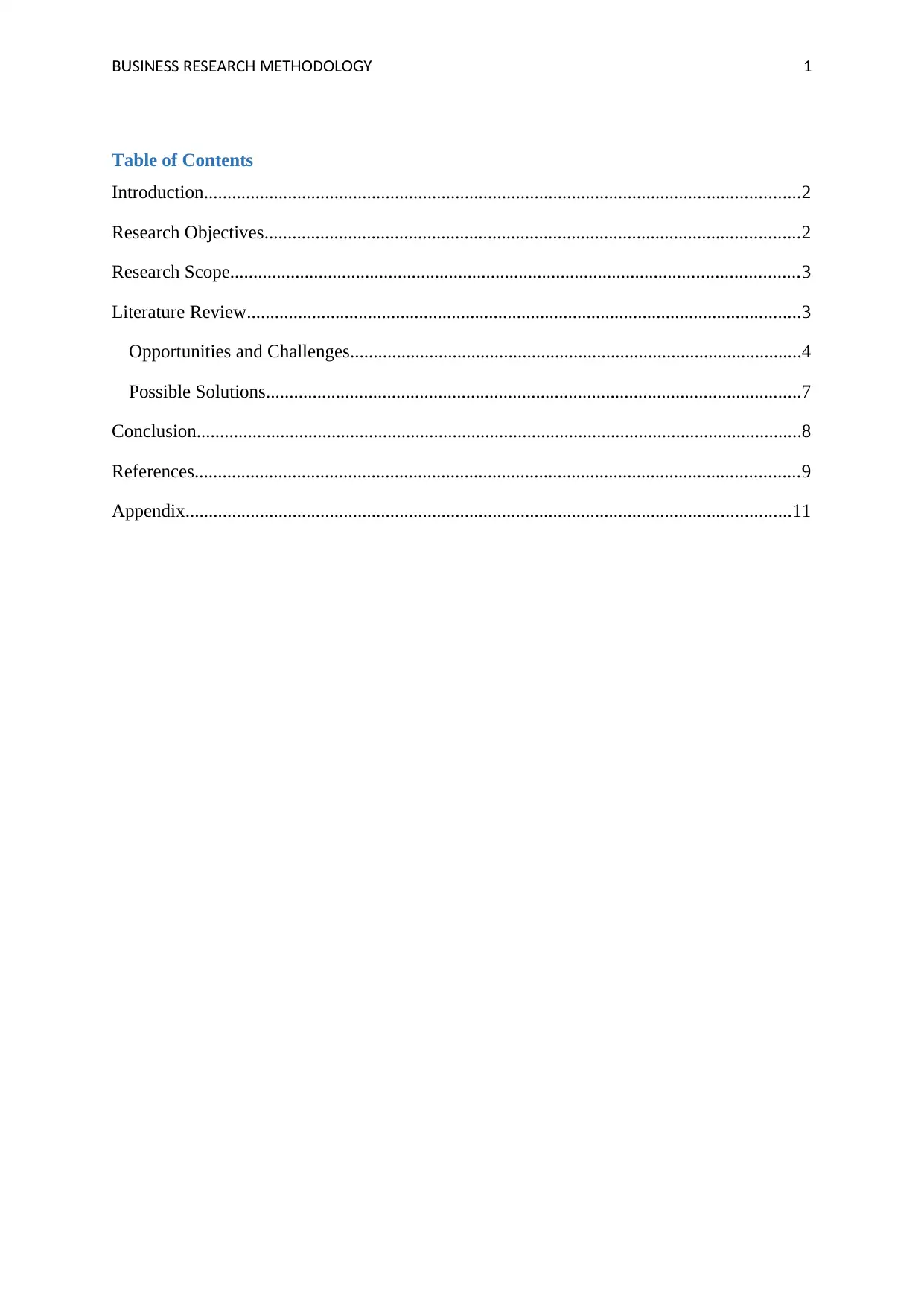
S SS R S ARC M DBU INE E E H ETHO OLOGY 1
Table of Contents
Introduction................................................................................................................................2
Research Objectives...................................................................................................................2
Research Scope..........................................................................................................................3
Literature Review.......................................................................................................................3
Opportunities and Challenges.................................................................................................4
Possible Solutions...................................................................................................................7
Conclusion..................................................................................................................................8
References..................................................................................................................................9
Appendix..................................................................................................................................11
Table of Contents
Introduction................................................................................................................................2
Research Objectives...................................................................................................................2
Research Scope..........................................................................................................................3
Literature Review.......................................................................................................................3
Opportunities and Challenges.................................................................................................4
Possible Solutions...................................................................................................................7
Conclusion..................................................................................................................................8
References..................................................................................................................................9
Appendix..................................................................................................................................11
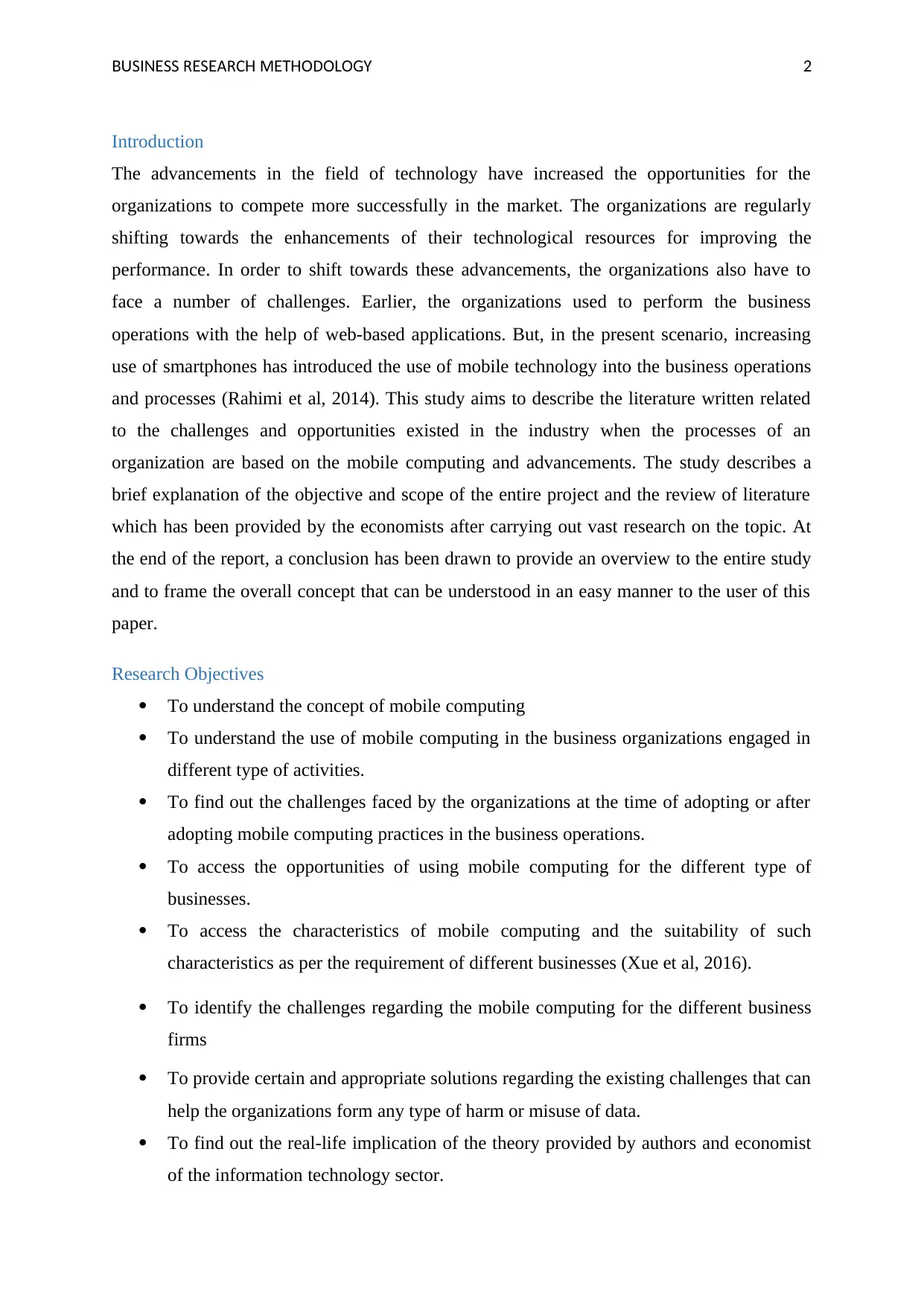
S SS R S ARC M DBU INE E E H ETHO OLOGY 2
Introduction
The advancements in the field of technology have increased the opportunities for the
organizations to compete more successfully in the market. The organizations are regularly
shifting towards the enhancements of their technological resources for improving the
performance. In order to shift towards these advancements, the organizations also have to
face a number of challenges. Earlier, the organizations used to perform the business
operations with the help of web-based applications. But, in the present scenario, increasing
use of smartphones has introduced the use of mobile technology into the business operations
and processes (Rahimi et al, 2014). This study aims to describe the literature written related
to the challenges and opportunities existed in the industry when the processes of an
organization are based on the mobile computing and advancements. The study describes a
brief explanation of the objective and scope of the entire project and the review of literature
which has been provided by the economists after carrying out vast research on the topic. At
the end of the report, a conclusion has been drawn to provide an overview to the entire study
and to frame the overall concept that can be understood in an easy manner to the user of this
paper.
Research Objectives
To understand the concept of mobile computing
To understand the use of mobile computing in the business organizations engaged in
different type of activities.
To find out the challenges faced by the organizations at the time of adopting or after
adopting mobile computing practices in the business operations.
To access the opportunities of using mobile computing for the different type of
businesses.
To access the characteristics of mobile computing and the suitability of such
characteristics as per the requirement of different businesses (Xue et al, 2016).
To identify the challenges regarding the mobile computing for the different business
firms
To provide certain and appropriate solutions regarding the existing challenges that can
help the organizations form any type of harm or misuse of data.
To find out the real-life implication of the theory provided by authors and economist
of the information technology sector.
Introduction
The advancements in the field of technology have increased the opportunities for the
organizations to compete more successfully in the market. The organizations are regularly
shifting towards the enhancements of their technological resources for improving the
performance. In order to shift towards these advancements, the organizations also have to
face a number of challenges. Earlier, the organizations used to perform the business
operations with the help of web-based applications. But, in the present scenario, increasing
use of smartphones has introduced the use of mobile technology into the business operations
and processes (Rahimi et al, 2014). This study aims to describe the literature written related
to the challenges and opportunities existed in the industry when the processes of an
organization are based on the mobile computing and advancements. The study describes a
brief explanation of the objective and scope of the entire project and the review of literature
which has been provided by the economists after carrying out vast research on the topic. At
the end of the report, a conclusion has been drawn to provide an overview to the entire study
and to frame the overall concept that can be understood in an easy manner to the user of this
paper.
Research Objectives
To understand the concept of mobile computing
To understand the use of mobile computing in the business organizations engaged in
different type of activities.
To find out the challenges faced by the organizations at the time of adopting or after
adopting mobile computing practices in the business operations.
To access the opportunities of using mobile computing for the different type of
businesses.
To access the characteristics of mobile computing and the suitability of such
characteristics as per the requirement of different businesses (Xue et al, 2016).
To identify the challenges regarding the mobile computing for the different business
firms
To provide certain and appropriate solutions regarding the existing challenges that can
help the organizations form any type of harm or misuse of data.
To find out the real-life implication of the theory provided by authors and economist
of the information technology sector.
⊘ This is a preview!⊘
Do you want full access?
Subscribe today to unlock all pages.

Trusted by 1+ million students worldwide
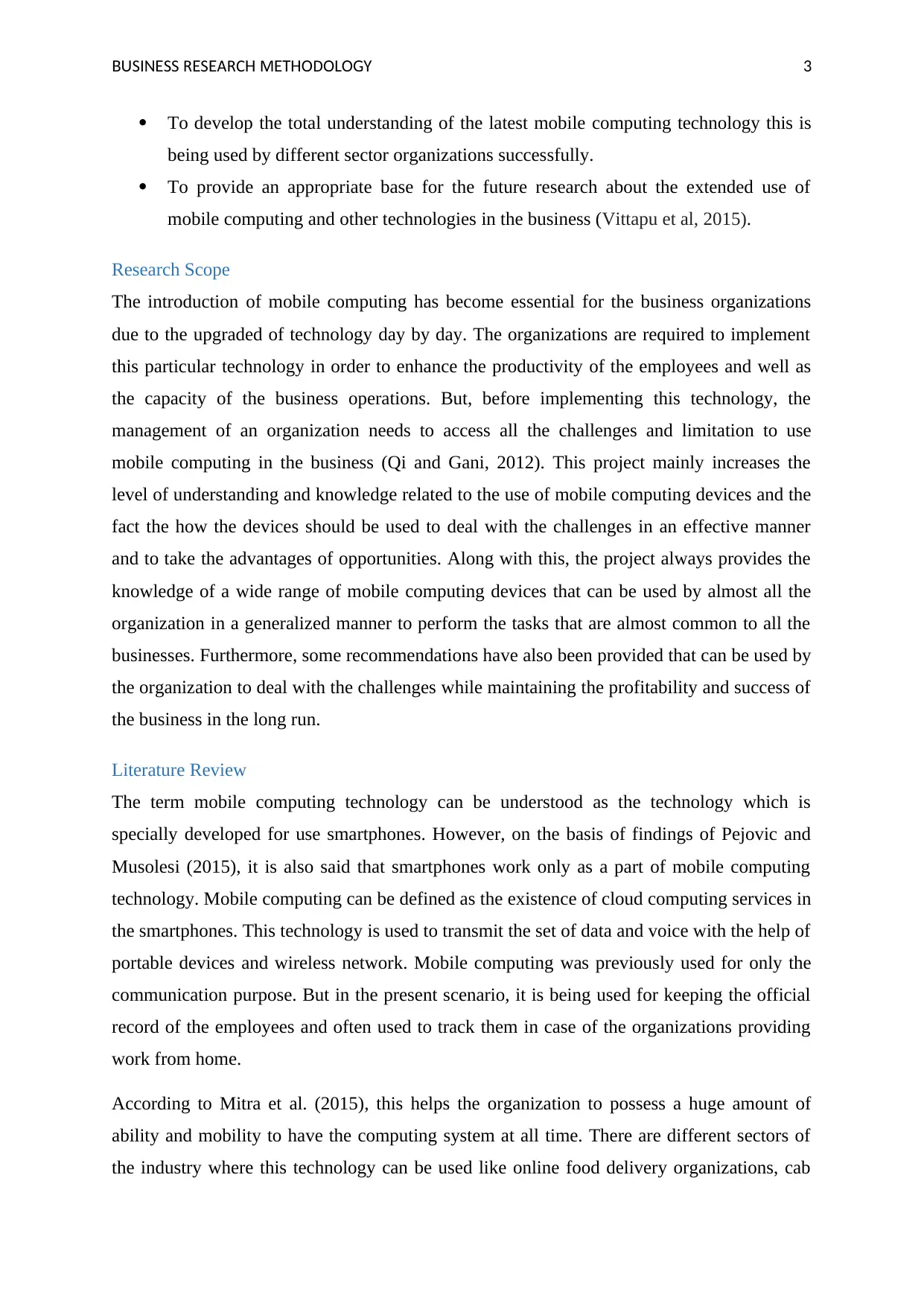
S SS R S ARC M DBU INE E E H ETHO OLOGY 3
To develop the total understanding of the latest mobile computing technology this is
being used by different sector organizations successfully.
To provide an appropriate base for the future research about the extended use of
mobile computing and other technologies in the business (Vittapu et al, 2015).
Research Scope
The introduction of mobile computing has become essential for the business organizations
due to the upgraded of technology day by day. The organizations are required to implement
this particular technology in order to enhance the productivity of the employees and well as
the capacity of the business operations. But, before implementing this technology, the
management of an organization needs to access all the challenges and limitation to use
mobile computing in the business (Qi and Gani, 2012). This project mainly increases the
level of understanding and knowledge related to the use of mobile computing devices and the
fact the how the devices should be used to deal with the challenges in an effective manner
and to take the advantages of opportunities. Along with this, the project always provides the
knowledge of a wide range of mobile computing devices that can be used by almost all the
organization in a generalized manner to perform the tasks that are almost common to all the
businesses. Furthermore, some recommendations have also been provided that can be used by
the organization to deal with the challenges while maintaining the profitability and success of
the business in the long run.
Literature Review
The term mobile computing technology can be understood as the technology which is
specially developed for use smartphones. However, on the basis of findings of Pejovic and
Musolesi (2015), it is also said that smartphones work only as a part of mobile computing
technology. Mobile computing can be defined as the existence of cloud computing services in
the smartphones. This technology is used to transmit the set of data and voice with the help of
portable devices and wireless network. Mobile computing was previously used for only the
communication purpose. But in the present scenario, it is being used for keeping the official
record of the employees and often used to track them in case of the organizations providing
work from home.
According to Mitra et al. (2015), this helps the organization to possess a huge amount of
ability and mobility to have the computing system at all time. There are different sectors of
the industry where this technology can be used like online food delivery organizations, cab
To develop the total understanding of the latest mobile computing technology this is
being used by different sector organizations successfully.
To provide an appropriate base for the future research about the extended use of
mobile computing and other technologies in the business (Vittapu et al, 2015).
Research Scope
The introduction of mobile computing has become essential for the business organizations
due to the upgraded of technology day by day. The organizations are required to implement
this particular technology in order to enhance the productivity of the employees and well as
the capacity of the business operations. But, before implementing this technology, the
management of an organization needs to access all the challenges and limitation to use
mobile computing in the business (Qi and Gani, 2012). This project mainly increases the
level of understanding and knowledge related to the use of mobile computing devices and the
fact the how the devices should be used to deal with the challenges in an effective manner
and to take the advantages of opportunities. Along with this, the project always provides the
knowledge of a wide range of mobile computing devices that can be used by almost all the
organization in a generalized manner to perform the tasks that are almost common to all the
businesses. Furthermore, some recommendations have also been provided that can be used by
the organization to deal with the challenges while maintaining the profitability and success of
the business in the long run.
Literature Review
The term mobile computing technology can be understood as the technology which is
specially developed for use smartphones. However, on the basis of findings of Pejovic and
Musolesi (2015), it is also said that smartphones work only as a part of mobile computing
technology. Mobile computing can be defined as the existence of cloud computing services in
the smartphones. This technology is used to transmit the set of data and voice with the help of
portable devices and wireless network. Mobile computing was previously used for only the
communication purpose. But in the present scenario, it is being used for keeping the official
record of the employees and often used to track them in case of the organizations providing
work from home.
According to Mitra et al. (2015), this helps the organization to possess a huge amount of
ability and mobility to have the computing system at all time. There are different sectors of
the industry where this technology can be used like online food delivery organizations, cab
Paraphrase This Document
Need a fresh take? Get an instant paraphrase of this document with our AI Paraphraser
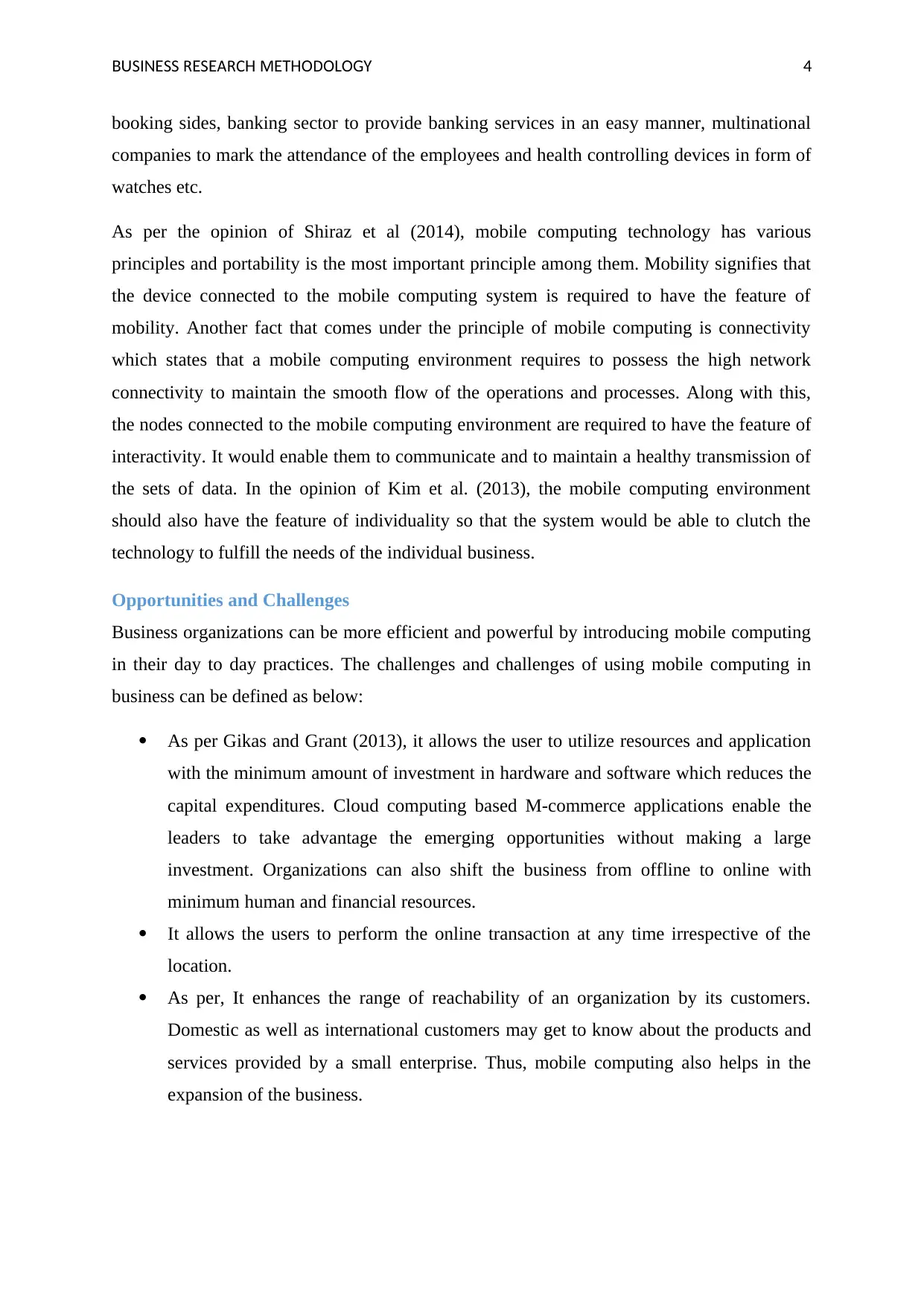
S SS R S ARC M DBU INE E E H ETHO OLOGY 4
booking sides, banking sector to provide banking services in an easy manner, multinational
companies to mark the attendance of the employees and health controlling devices in form of
watches etc.
As per the opinion of Shiraz et al (2014), mobile computing technology has various
principles and portability is the most important principle among them. Mobility signifies that
the device connected to the mobile computing system is required to have the feature of
mobility. Another fact that comes under the principle of mobile computing is connectivity
which states that a mobile computing environment requires to possess the high network
connectivity to maintain the smooth flow of the operations and processes. Along with this,
the nodes connected to the mobile computing environment are required to have the feature of
interactivity. It would enable them to communicate and to maintain a healthy transmission of
the sets of data. In the opinion of Kim et al. (2013), the mobile computing environment
should also have the feature of individuality so that the system would be able to clutch the
technology to fulfill the needs of the individual business.
Opportunities and Challenges
Business organizations can be more efficient and powerful by introducing mobile computing
in their day to day practices. The challenges and challenges of using mobile computing in
business can be defined as below:
As per Gikas and Grant (2013), it allows the user to utilize resources and application
with the minimum amount of investment in hardware and software which reduces the
capital expenditures. Cloud computing based M-commerce applications enable the
leaders to take advantage the emerging opportunities without making a large
investment. Organizations can also shift the business from offline to online with
minimum human and financial resources.
It allows the users to perform the online transaction at any time irrespective of the
location.
As per, It enhances the range of reachability of an organization by its customers.
Domestic as well as international customers may get to know about the products and
services provided by a small enterprise. Thus, mobile computing also helps in the
expansion of the business.
booking sides, banking sector to provide banking services in an easy manner, multinational
companies to mark the attendance of the employees and health controlling devices in form of
watches etc.
As per the opinion of Shiraz et al (2014), mobile computing technology has various
principles and portability is the most important principle among them. Mobility signifies that
the device connected to the mobile computing system is required to have the feature of
mobility. Another fact that comes under the principle of mobile computing is connectivity
which states that a mobile computing environment requires to possess the high network
connectivity to maintain the smooth flow of the operations and processes. Along with this,
the nodes connected to the mobile computing environment are required to have the feature of
interactivity. It would enable them to communicate and to maintain a healthy transmission of
the sets of data. In the opinion of Kim et al. (2013), the mobile computing environment
should also have the feature of individuality so that the system would be able to clutch the
technology to fulfill the needs of the individual business.
Opportunities and Challenges
Business organizations can be more efficient and powerful by introducing mobile computing
in their day to day practices. The challenges and challenges of using mobile computing in
business can be defined as below:
As per Gikas and Grant (2013), it allows the user to utilize resources and application
with the minimum amount of investment in hardware and software which reduces the
capital expenditures. Cloud computing based M-commerce applications enable the
leaders to take advantage the emerging opportunities without making a large
investment. Organizations can also shift the business from offline to online with
minimum human and financial resources.
It allows the users to perform the online transaction at any time irrespective of the
location.
As per, It enhances the range of reachability of an organization by its customers.
Domestic as well as international customers may get to know about the products and
services provided by a small enterprise. Thus, mobile computing also helps in the
expansion of the business.
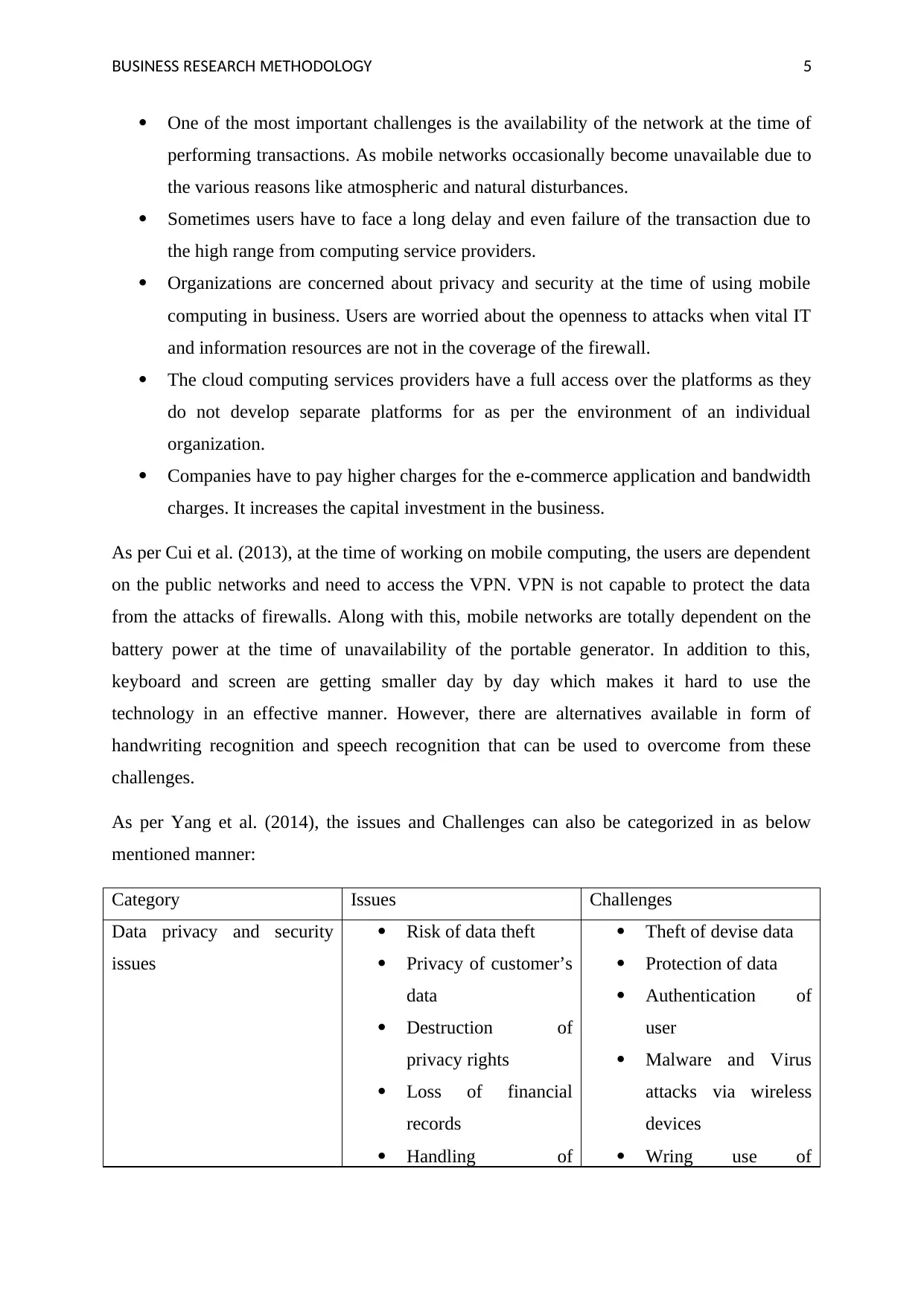
S SS R S ARC M DBU INE E E H ETHO OLOGY 5
One of the most important challenges is the availability of the network at the time of
performing transactions. As mobile networks occasionally become unavailable due to
the various reasons like atmospheric and natural disturbances.
Sometimes users have to face a long delay and even failure of the transaction due to
the high range from computing service providers.
Organizations are concerned about privacy and security at the time of using mobile
computing in business. Users are worried about the openness to attacks when vital IT
and information resources are not in the coverage of the firewall.
The cloud computing services providers have a full access over the platforms as they
do not develop separate platforms for as per the environment of an individual
organization.
Companies have to pay higher charges for the e-commerce application and bandwidth
charges. It increases the capital investment in the business.
As per Cui et al. (2013), at the time of working on mobile computing, the users are dependent
on the public networks and need to access the VPN. VPN is not capable to protect the data
from the attacks of firewalls. Along with this, mobile networks are totally dependent on the
battery power at the time of unavailability of the portable generator. In addition to this,
keyboard and screen are getting smaller day by day which makes it hard to use the
technology in an effective manner. However, there are alternatives available in form of
handwriting recognition and speech recognition that can be used to overcome from these
challenges.
As per Yang et al. (2014), the issues and Challenges can also be categorized in as below
mentioned manner:
Category Issues Challenges
Data privacy and security
issues
Risk of data theft
Privacy of customer’s
data
Destruction of
privacy rights
Loss of financial
records
Handling of
Theft of devise data
Protection of data
Authentication of
user
Malware and Virus
attacks via wireless
devices
Wring use of
One of the most important challenges is the availability of the network at the time of
performing transactions. As mobile networks occasionally become unavailable due to
the various reasons like atmospheric and natural disturbances.
Sometimes users have to face a long delay and even failure of the transaction due to
the high range from computing service providers.
Organizations are concerned about privacy and security at the time of using mobile
computing in business. Users are worried about the openness to attacks when vital IT
and information resources are not in the coverage of the firewall.
The cloud computing services providers have a full access over the platforms as they
do not develop separate platforms for as per the environment of an individual
organization.
Companies have to pay higher charges for the e-commerce application and bandwidth
charges. It increases the capital investment in the business.
As per Cui et al. (2013), at the time of working on mobile computing, the users are dependent
on the public networks and need to access the VPN. VPN is not capable to protect the data
from the attacks of firewalls. Along with this, mobile networks are totally dependent on the
battery power at the time of unavailability of the portable generator. In addition to this,
keyboard and screen are getting smaller day by day which makes it hard to use the
technology in an effective manner. However, there are alternatives available in form of
handwriting recognition and speech recognition that can be used to overcome from these
challenges.
As per Yang et al. (2014), the issues and Challenges can also be categorized in as below
mentioned manner:
Category Issues Challenges
Data privacy and security
issues
Risk of data theft
Privacy of customer’s
data
Destruction of
privacy rights
Loss of financial
records
Handling of
Theft of devise data
Protection of data
Authentication of
user
Malware and Virus
attacks via wireless
devices
Wring use of
⊘ This is a preview!⊘
Do you want full access?
Subscribe today to unlock all pages.

Trusted by 1+ million students worldwide
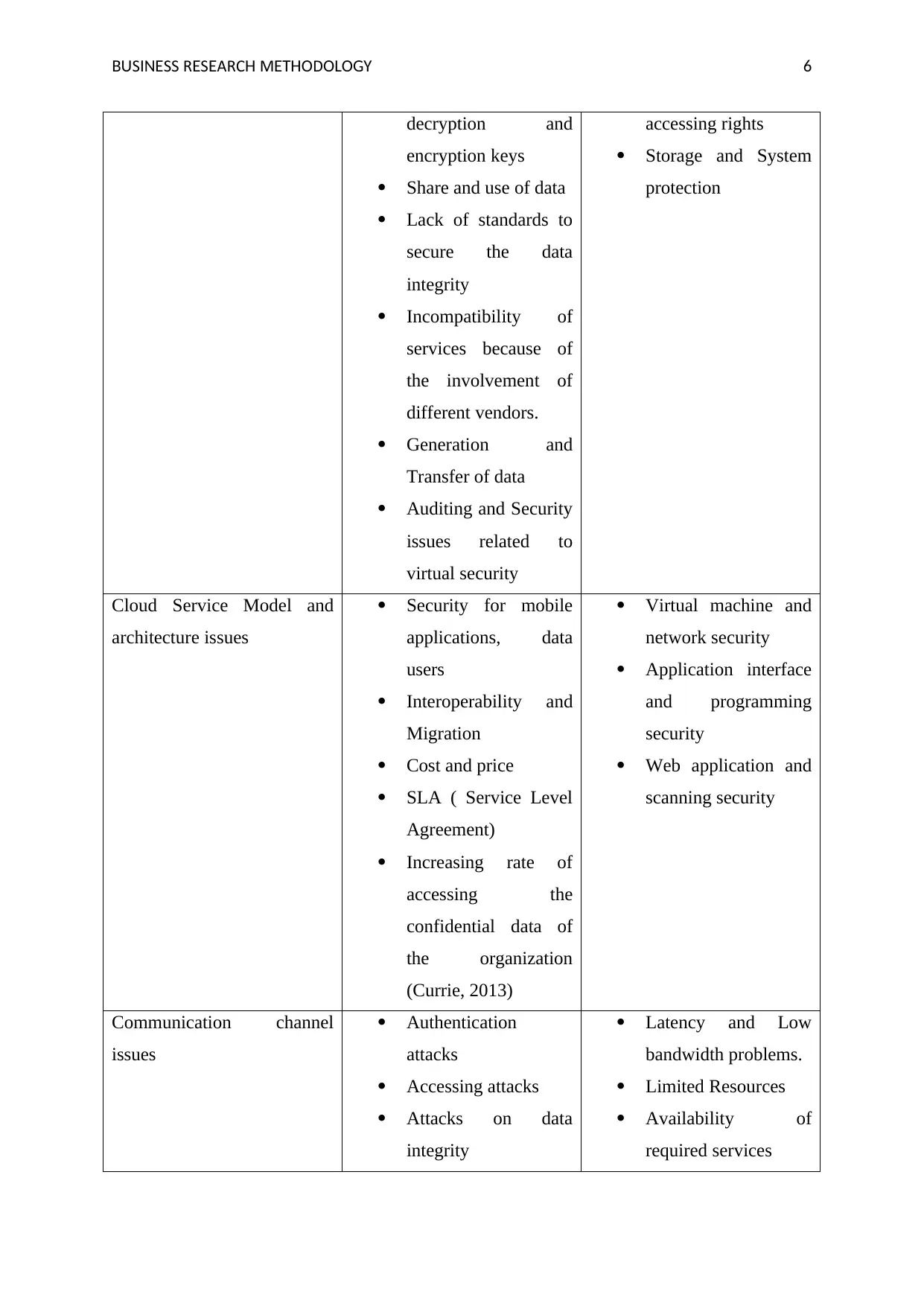
S SS R S ARC M DBU INE E E H ETHO OLOGY 6
decryption and
encryption keys
Share and use of data
Lack of standards to
secure the data
integrity
Incompatibility of
services because of
the involvement of
different vendors.
Generation and
Transfer of data
Auditing and Security
issues related to
virtual security
accessing rights
Storage and System
protection
Cloud Service Model and
architecture issues
Security for mobile
applications, data
users
Interoperability and
Migration
Cost and price
SLA ( Service Level
Agreement)
Increasing rate of
accessing the
confidential data of
the organization
(Currie, 2013)
Virtual machine and
network security
Application interface
and programming
security
Web application and
scanning security
Communication channel
issues
Authentication
attacks
Accessing attacks
Attacks on data
integrity
Latency and Low
bandwidth problems.
Limited Resources
Availability of
required services
decryption and
encryption keys
Share and use of data
Lack of standards to
secure the data
integrity
Incompatibility of
services because of
the involvement of
different vendors.
Generation and
Transfer of data
Auditing and Security
issues related to
virtual security
accessing rights
Storage and System
protection
Cloud Service Model and
architecture issues
Security for mobile
applications, data
users
Interoperability and
Migration
Cost and price
SLA ( Service Level
Agreement)
Increasing rate of
accessing the
confidential data of
the organization
(Currie, 2013)
Virtual machine and
network security
Application interface
and programming
security
Web application and
scanning security
Communication channel
issues
Authentication
attacks
Accessing attacks
Attacks on data
integrity
Latency and Low
bandwidth problems.
Limited Resources
Availability of
required services
Paraphrase This Document
Need a fresh take? Get an instant paraphrase of this document with our AI Paraphraser
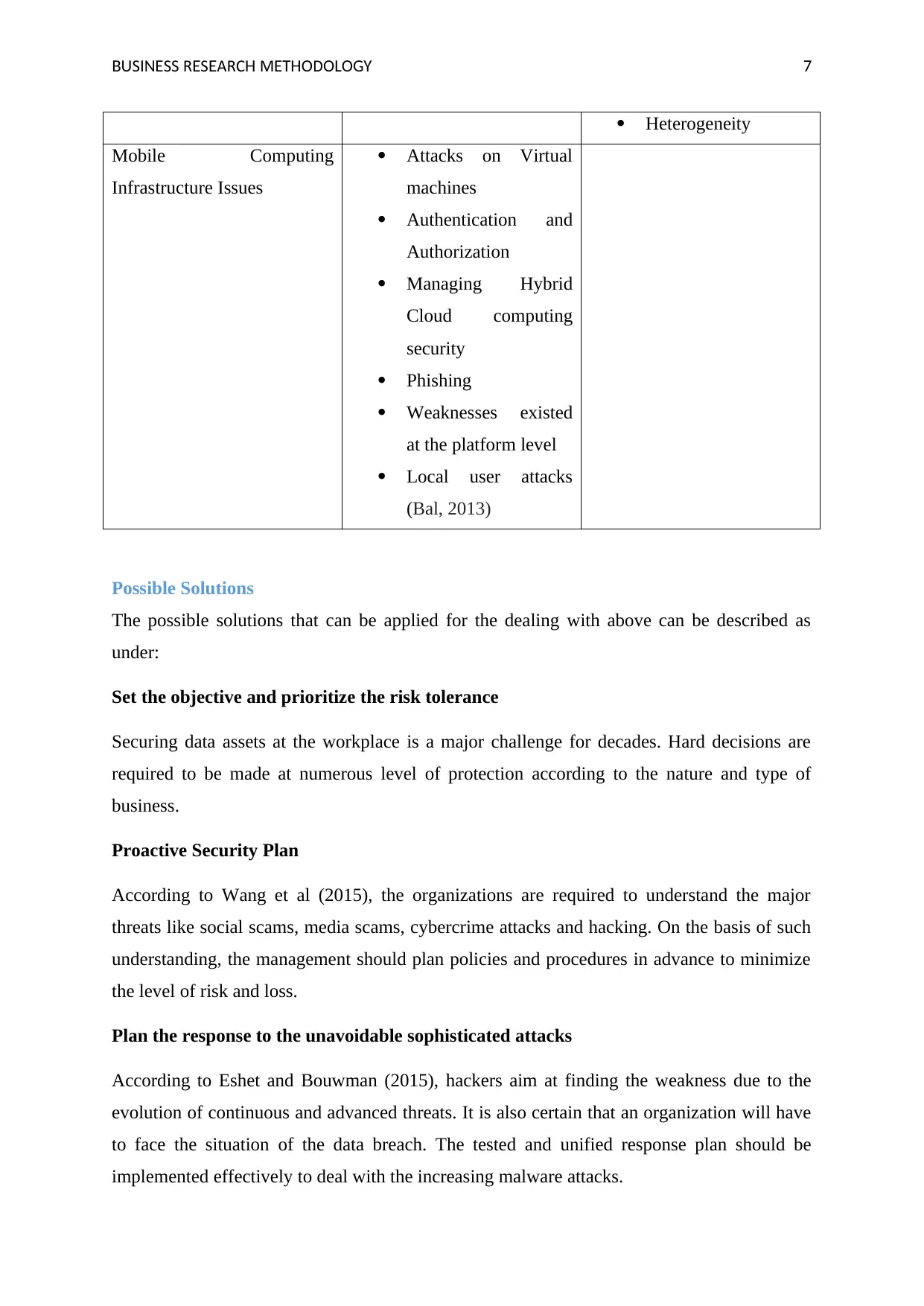
S SS R S ARC M DBU INE E E H ETHO OLOGY 7
Heterogeneity
Mobile Computing
Infrastructure Issues
Attacks on Virtual
machines
Authentication and
Authorization
Managing Hybrid
Cloud computing
security
Phishing
Weaknesses existed
at the platform level
Local user attacks
(Bal, 2013)
Possible Solutions
The possible solutions that can be applied for the dealing with above can be described as
under:
Set the objective and prioritize the risk tolerance
Securing data assets at the workplace is a major challenge for decades. Hard decisions are
required to be made at numerous level of protection according to the nature and type of
business.
Proactive Security Plan
According to Wang et al (2015), the organizations are required to understand the major
threats like social scams, media scams, cybercrime attacks and hacking. On the basis of such
understanding, the management should plan policies and procedures in advance to minimize
the level of risk and loss.
Plan the response to the unavoidable sophisticated attacks
According to Eshet and Bouwman (2015), hackers aim at finding the weakness due to the
evolution of continuous and advanced threats. It is also certain that an organization will have
to face the situation of the data breach. The tested and unified response plan should be
implemented effectively to deal with the increasing malware attacks.
Heterogeneity
Mobile Computing
Infrastructure Issues
Attacks on Virtual
machines
Authentication and
Authorization
Managing Hybrid
Cloud computing
security
Phishing
Weaknesses existed
at the platform level
Local user attacks
(Bal, 2013)
Possible Solutions
The possible solutions that can be applied for the dealing with above can be described as
under:
Set the objective and prioritize the risk tolerance
Securing data assets at the workplace is a major challenge for decades. Hard decisions are
required to be made at numerous level of protection according to the nature and type of
business.
Proactive Security Plan
According to Wang et al (2015), the organizations are required to understand the major
threats like social scams, media scams, cybercrime attacks and hacking. On the basis of such
understanding, the management should plan policies and procedures in advance to minimize
the level of risk and loss.
Plan the response to the unavoidable sophisticated attacks
According to Eshet and Bouwman (2015), hackers aim at finding the weakness due to the
evolution of continuous and advanced threats. It is also certain that an organization will have
to face the situation of the data breach. The tested and unified response plan should be
implemented effectively to deal with the increasing malware attacks.
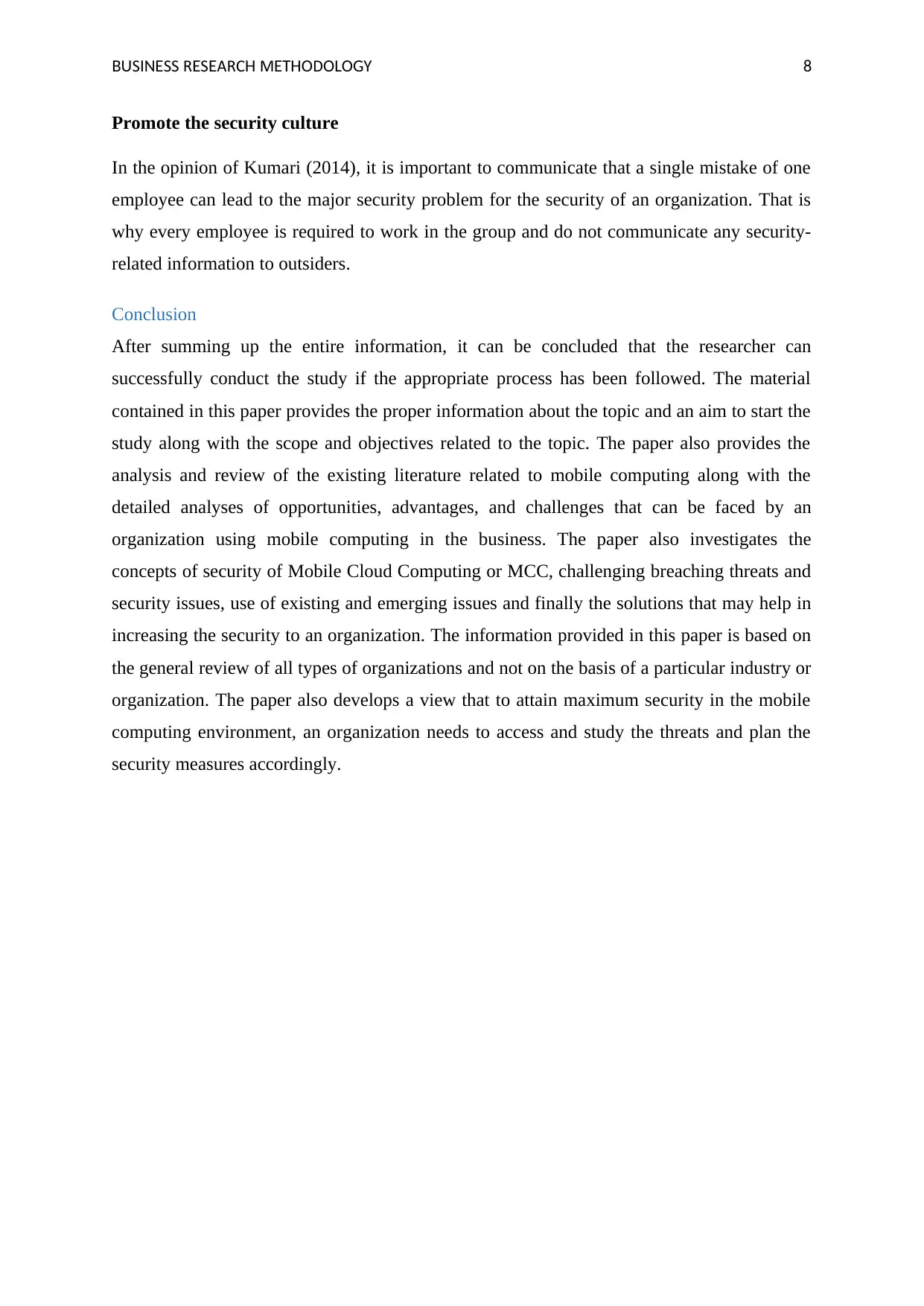
S SS R S ARC M DBU INE E E H ETHO OLOGY 8
Promote the security culture
In the opinion of Kumari (2014), it is important to communicate that a single mistake of one
employee can lead to the major security problem for the security of an organization. That is
why every employee is required to work in the group and do not communicate any security-
related information to outsiders.
Conclusion
After summing up the entire information, it can be concluded that the researcher can
successfully conduct the study if the appropriate process has been followed. The material
contained in this paper provides the proper information about the topic and an aim to start the
study along with the scope and objectives related to the topic. The paper also provides the
analysis and review of the existing literature related to mobile computing along with the
detailed analyses of opportunities, advantages, and challenges that can be faced by an
organization using mobile computing in the business. The paper also investigates the
concepts of security of Mobile Cloud Computing or MCC, challenging breaching threats and
security issues, use of existing and emerging issues and finally the solutions that may help in
increasing the security to an organization. The information provided in this paper is based on
the general review of all types of organizations and not on the basis of a particular industry or
organization. The paper also develops a view that to attain maximum security in the mobile
computing environment, an organization needs to access and study the threats and plan the
security measures accordingly.
Promote the security culture
In the opinion of Kumari (2014), it is important to communicate that a single mistake of one
employee can lead to the major security problem for the security of an organization. That is
why every employee is required to work in the group and do not communicate any security-
related information to outsiders.
Conclusion
After summing up the entire information, it can be concluded that the researcher can
successfully conduct the study if the appropriate process has been followed. The material
contained in this paper provides the proper information about the topic and an aim to start the
study along with the scope and objectives related to the topic. The paper also provides the
analysis and review of the existing literature related to mobile computing along with the
detailed analyses of opportunities, advantages, and challenges that can be faced by an
organization using mobile computing in the business. The paper also investigates the
concepts of security of Mobile Cloud Computing or MCC, challenging breaching threats and
security issues, use of existing and emerging issues and finally the solutions that may help in
increasing the security to an organization. The information provided in this paper is based on
the general review of all types of organizations and not on the basis of a particular industry or
organization. The paper also develops a view that to attain maximum security in the mobile
computing environment, an organization needs to access and study the threats and plan the
security measures accordingly.
⊘ This is a preview!⊘
Do you want full access?
Subscribe today to unlock all pages.

Trusted by 1+ million students worldwide
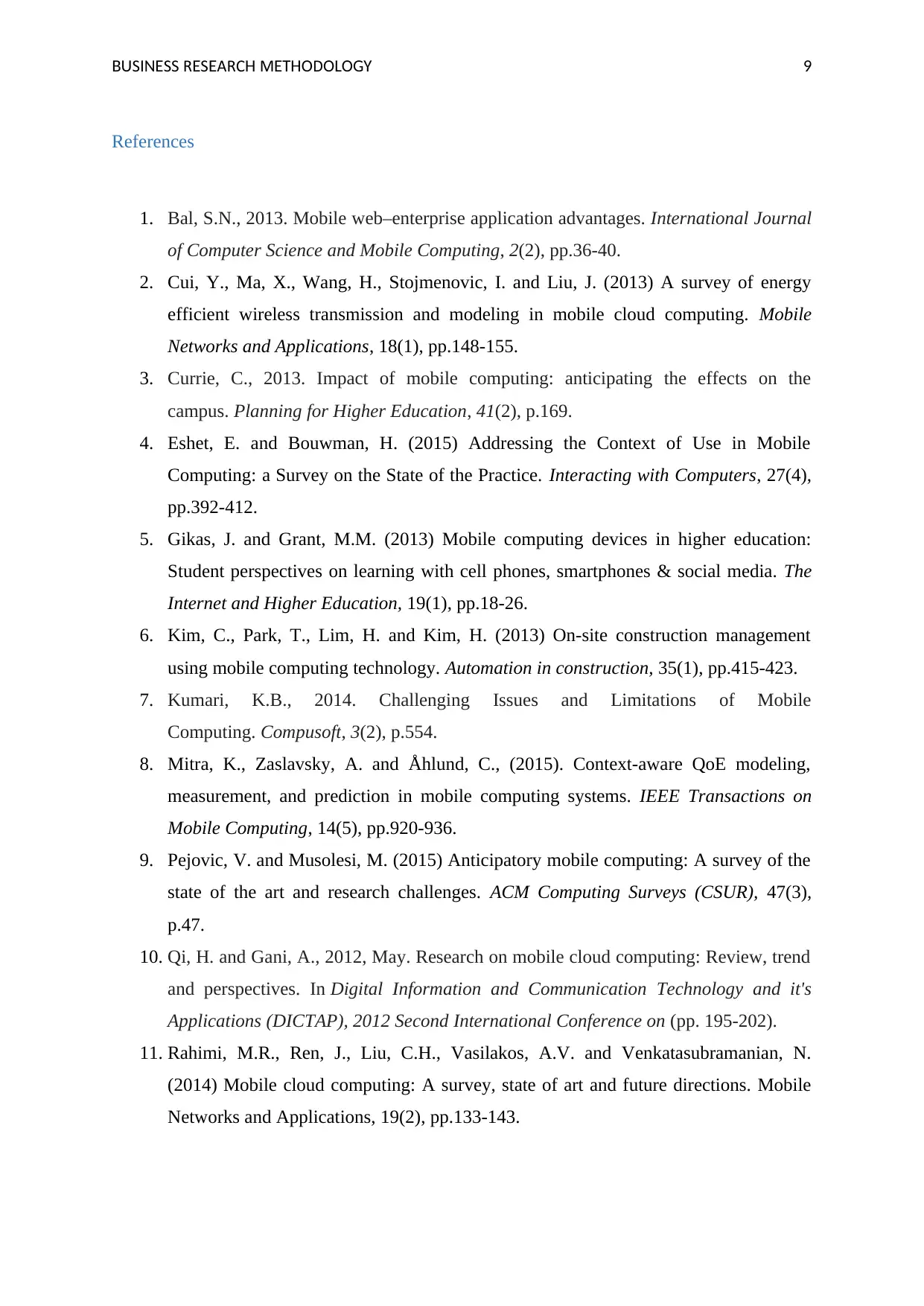
S SS R S ARC M DBU INE E E H ETHO OLOGY 9
References
1. Bal, S.N., 2013. Mobile web–enterprise application advantages. International Journal
of Computer Science and Mobile Computing, 2(2), pp.36-40.
2. Cui, Y., Ma, X., Wang, H., Stojmenovic, I. and Liu, J. (2013) A survey of energy
efficient wireless transmission and modeling in mobile cloud computing. Mobile
Networks and Applications, 18(1), pp.148-155.
3. Currie, C., 2013. Impact of mobile computing: anticipating the effects on the
campus. Planning for Higher Education, 41(2), p.169.
4. Eshet, E. and Bouwman, H. (2015) Addressing the Context of Use in Mobile
Computing: a Survey on the State of the Practice. Interacting with Computers, 27(4),
pp.392-412.
5. Gikas, J. and Grant, M.M. (2013) Mobile computing devices in higher education:
Student perspectives on learning with cell phones, smartphones & social media. The
Internet and Higher Education, 19(1), pp.18-26.
6. Kim, C., Park, T., Lim, H. and Kim, H. (2013) On-site construction management
using mobile computing technology. Automation in construction, 35(1), pp.415-423.
7. Kumari, K.B., 2014. Challenging Issues and Limitations of Mobile
Computing. Compusoft, 3(2), p.554.
8. Mitra, K., Zaslavsky, A. and Åhlund, C., (2015). Context-aware QoE modeling,
measurement, and prediction in mobile computing systems. IEEE Transactions on
Mobile Computing, 14(5), pp.920-936.
9. Pejovic, V. and Musolesi, M. (2015) Anticipatory mobile computing: A survey of the
state of the art and research challenges. ACM Computing Surveys (CSUR), 47(3),
p.47.
10. Qi, H. and Gani, A., 2012, May. Research on mobile cloud computing: Review, trend
and perspectives. In Digital Information and Communication Technology and it's
Applications (DICTAP), 2012 Second International Conference on (pp. 195-202).
11. Rahimi, M.R., Ren, J., Liu, C.H., Vasilakos, A.V. and Venkatasubramanian, N.
(2014) Mobile cloud computing: A survey, state of art and future directions. Mobile
Networks and Applications, 19(2), pp.133-143.
References
1. Bal, S.N., 2013. Mobile web–enterprise application advantages. International Journal
of Computer Science and Mobile Computing, 2(2), pp.36-40.
2. Cui, Y., Ma, X., Wang, H., Stojmenovic, I. and Liu, J. (2013) A survey of energy
efficient wireless transmission and modeling in mobile cloud computing. Mobile
Networks and Applications, 18(1), pp.148-155.
3. Currie, C., 2013. Impact of mobile computing: anticipating the effects on the
campus. Planning for Higher Education, 41(2), p.169.
4. Eshet, E. and Bouwman, H. (2015) Addressing the Context of Use in Mobile
Computing: a Survey on the State of the Practice. Interacting with Computers, 27(4),
pp.392-412.
5. Gikas, J. and Grant, M.M. (2013) Mobile computing devices in higher education:
Student perspectives on learning with cell phones, smartphones & social media. The
Internet and Higher Education, 19(1), pp.18-26.
6. Kim, C., Park, T., Lim, H. and Kim, H. (2013) On-site construction management
using mobile computing technology. Automation in construction, 35(1), pp.415-423.
7. Kumari, K.B., 2014. Challenging Issues and Limitations of Mobile
Computing. Compusoft, 3(2), p.554.
8. Mitra, K., Zaslavsky, A. and Åhlund, C., (2015). Context-aware QoE modeling,
measurement, and prediction in mobile computing systems. IEEE Transactions on
Mobile Computing, 14(5), pp.920-936.
9. Pejovic, V. and Musolesi, M. (2015) Anticipatory mobile computing: A survey of the
state of the art and research challenges. ACM Computing Surveys (CSUR), 47(3),
p.47.
10. Qi, H. and Gani, A., 2012, May. Research on mobile cloud computing: Review, trend
and perspectives. In Digital Information and Communication Technology and it's
Applications (DICTAP), 2012 Second International Conference on (pp. 195-202).
11. Rahimi, M.R., Ren, J., Liu, C.H., Vasilakos, A.V. and Venkatasubramanian, N.
(2014) Mobile cloud computing: A survey, state of art and future directions. Mobile
Networks and Applications, 19(2), pp.133-143.
Paraphrase This Document
Need a fresh take? Get an instant paraphrase of this document with our AI Paraphraser
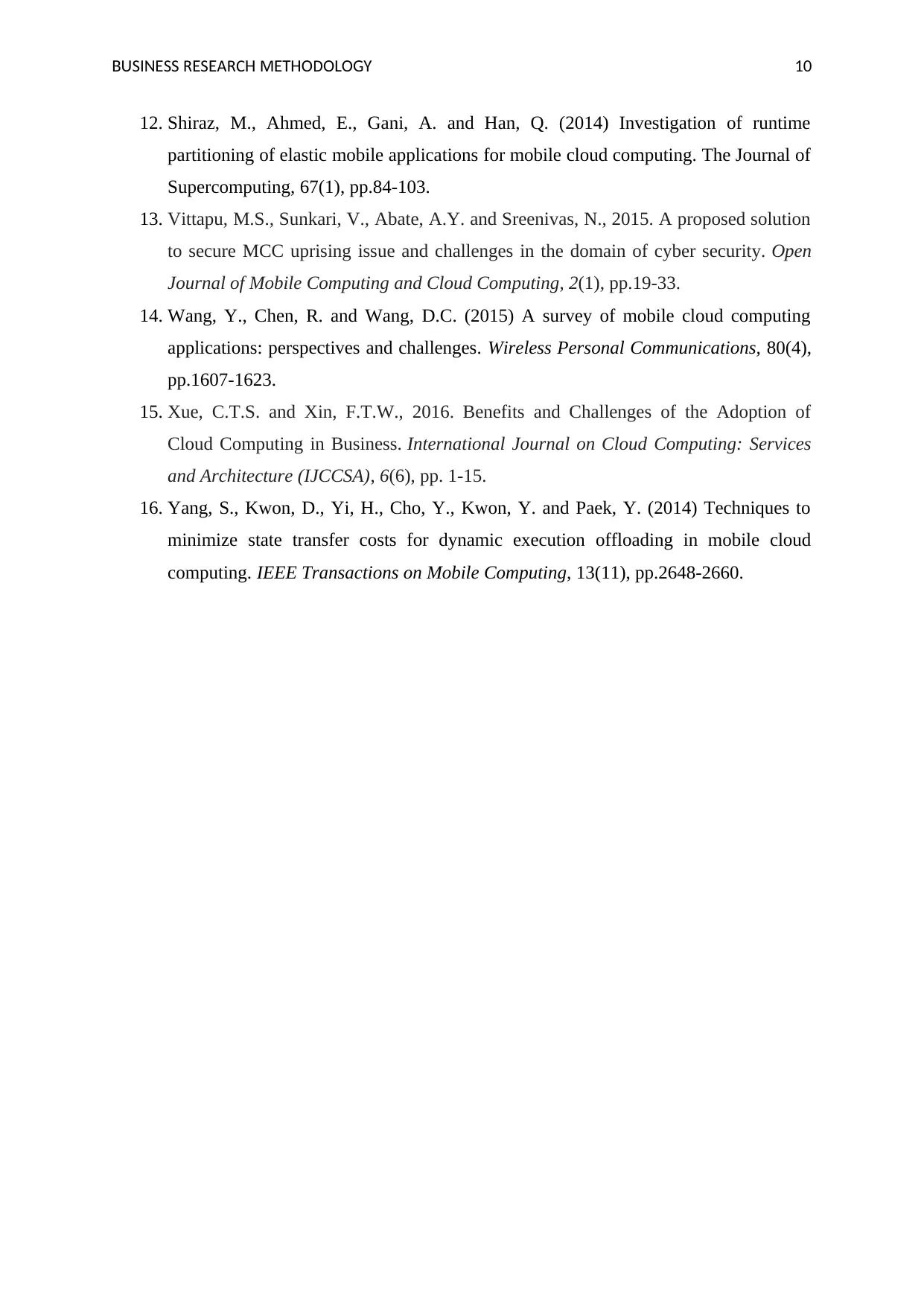
S SS R S ARC M DBU INE E E H ETHO OLOGY 10
12. Shiraz, M., Ahmed, E., Gani, A. and Han, Q. (2014) Investigation of runtime
partitioning of elastic mobile applications for mobile cloud computing. The Journal of
Supercomputing, 67(1), pp.84-103.
13. Vittapu, M.S., Sunkari, V., Abate, A.Y. and Sreenivas, N., 2015. A proposed solution
to secure MCC uprising issue and challenges in the domain of cyber security. Open
Journal of Mobile Computing and Cloud Computing, 2(1), pp.19-33.
14. Wang, Y., Chen, R. and Wang, D.C. (2015) A survey of mobile cloud computing
applications: perspectives and challenges. Wireless Personal Communications, 80(4),
pp.1607-1623.
15. Xue, C.T.S. and Xin, F.T.W., 2016. Benefits and Challenges of the Adoption of
Cloud Computing in Business. International Journal on Cloud Computing: Services
and Architecture (IJCCSA), 6(6), pp. 1-15.
16. Yang, S., Kwon, D., Yi, H., Cho, Y., Kwon, Y. and Paek, Y. (2014) Techniques to
minimize state transfer costs for dynamic execution offloading in mobile cloud
computing. IEEE Transactions on Mobile Computing, 13(11), pp.2648-2660.
12. Shiraz, M., Ahmed, E., Gani, A. and Han, Q. (2014) Investigation of runtime
partitioning of elastic mobile applications for mobile cloud computing. The Journal of
Supercomputing, 67(1), pp.84-103.
13. Vittapu, M.S., Sunkari, V., Abate, A.Y. and Sreenivas, N., 2015. A proposed solution
to secure MCC uprising issue and challenges in the domain of cyber security. Open
Journal of Mobile Computing and Cloud Computing, 2(1), pp.19-33.
14. Wang, Y., Chen, R. and Wang, D.C. (2015) A survey of mobile cloud computing
applications: perspectives and challenges. Wireless Personal Communications, 80(4),
pp.1607-1623.
15. Xue, C.T.S. and Xin, F.T.W., 2016. Benefits and Challenges of the Adoption of
Cloud Computing in Business. International Journal on Cloud Computing: Services
and Architecture (IJCCSA), 6(6), pp. 1-15.
16. Yang, S., Kwon, D., Yi, H., Cho, Y., Kwon, Y. and Paek, Y. (2014) Techniques to
minimize state transfer costs for dynamic execution offloading in mobile cloud
computing. IEEE Transactions on Mobile Computing, 13(11), pp.2648-2660.
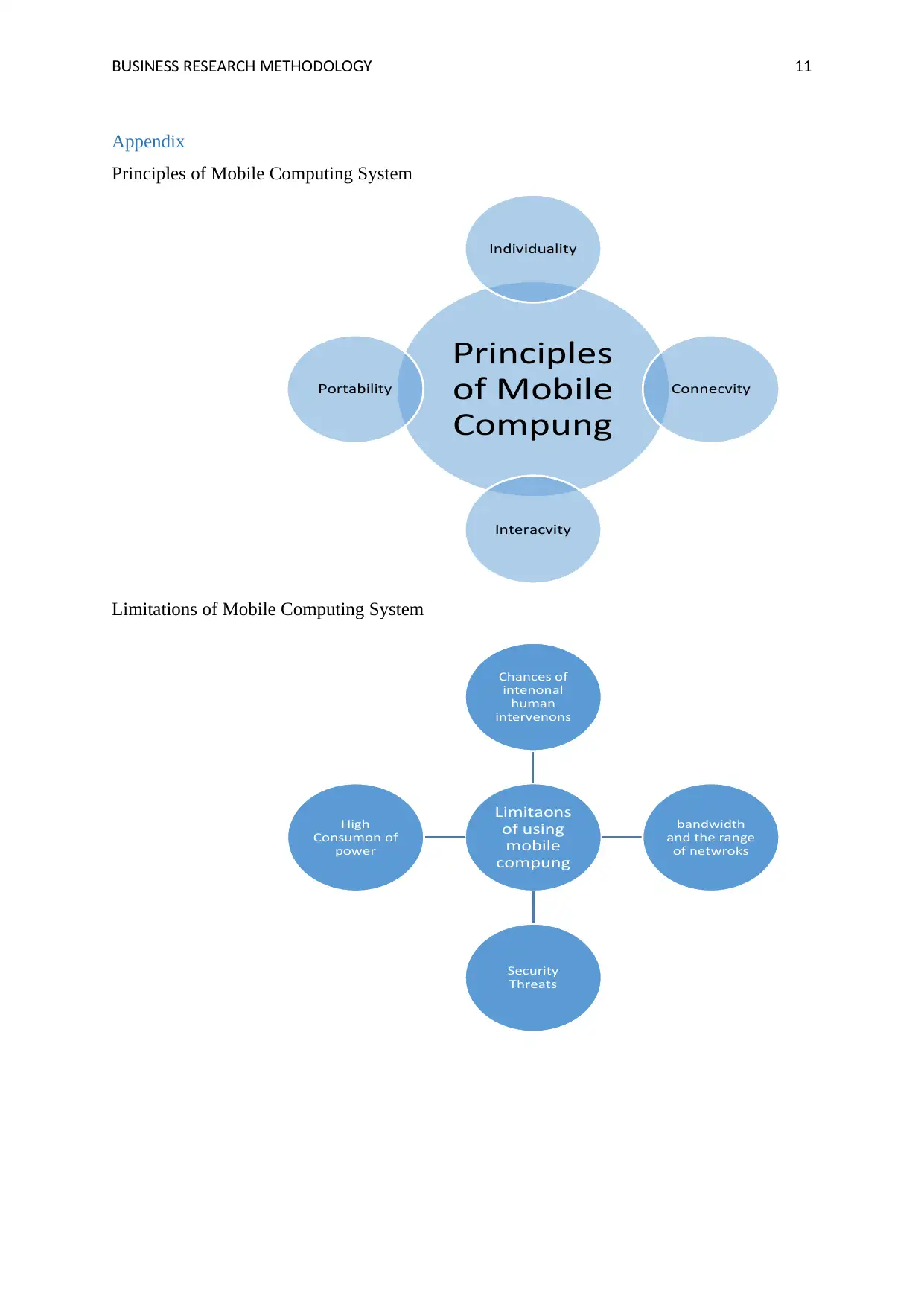
S SS R S ARC M DBU INE E E H ETHO OLOGY 11
Appendix
Principles of Mobile Computing System
Limitations of Mobile Computing System
rinciplesP
of Mobile
Computing
ndividualityI
Connectivity
nteractivityI
ortabilityP
imitationsL
of using
mobile
computing
Chances of
intentional
human
interventions
bandwidth
and the range
of netwroks
Security
hreatsT
ighH
Consumtion of
power
Appendix
Principles of Mobile Computing System
Limitations of Mobile Computing System
rinciplesP
of Mobile
Computing
ndividualityI
Connectivity
nteractivityI
ortabilityP
imitationsL
of using
mobile
computing
Chances of
intentional
human
interventions
bandwidth
and the range
of netwroks
Security
hreatsT
ighH
Consumtion of
power
⊘ This is a preview!⊘
Do you want full access?
Subscribe today to unlock all pages.

Trusted by 1+ million students worldwide
1 out of 13
Related Documents
Your All-in-One AI-Powered Toolkit for Academic Success.
+13062052269
info@desklib.com
Available 24*7 on WhatsApp / Email
![[object Object]](/_next/static/media/star-bottom.7253800d.svg)
Unlock your academic potential
Copyright © 2020–2025 A2Z Services. All Rights Reserved. Developed and managed by ZUCOL.





